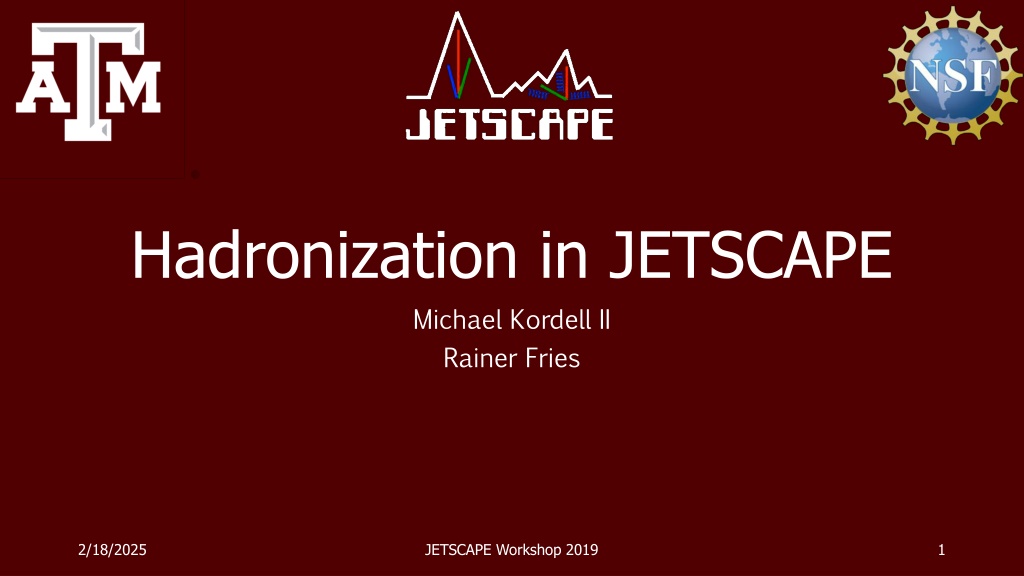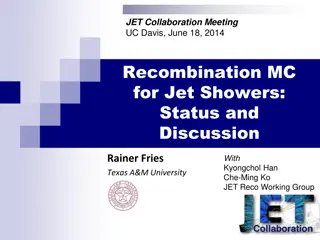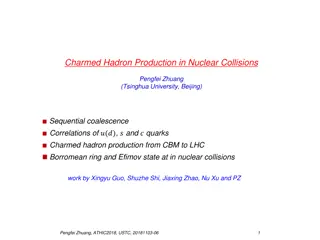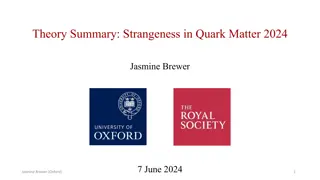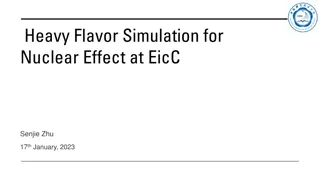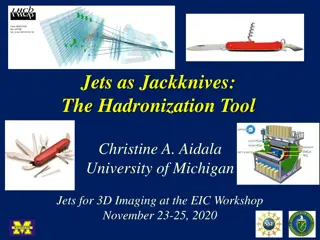Hadronization in JETSCAPE
In the JETSCAPE Workshop 2019, various hadronization models were explored, including independent fragmentation, string fragmentation, hybrid recombination, and quark recombination. The event delved into colorless and colored hadronization schemes within the framework, discussing processes like pairing off quarks based on momentum distance, gluon string assignments, and recombination of quarks into stable hadrons. The workshop showcased implementations of legacy FORTRAN code and new C++ code, along with preliminary results and future plans. Attendees learned about the evolution of hadronization concepts, from the Lund string fragmentation picture to modern quark recombination formalisms.
Download Presentation

Please find below an Image/Link to download the presentation.
The content on the website is provided AS IS for your information and personal use only. It may not be sold, licensed, or shared on other websites without obtaining consent from the author.If you encounter any issues during the download, it is possible that the publisher has removed the file from their server.
You are allowed to download the files provided on this website for personal or commercial use, subject to the condition that they are used lawfully. All files are the property of their respective owners.
The content on the website is provided AS IS for your information and personal use only. It may not be sold, licensed, or shared on other websites without obtaining consent from the author.
E N D
Presentation Transcript
Hadronization in JETSCAPE Michael Kordell II Rainer Fries 2/18/2025 JETSCAPE Workshop 2019 1
2/18/2025 JETSCAPE Workshop 2019 2 Overview Hadronization Models String Fragmentation Hadronization in the JETSCAPE Framework Recombination Hybrid Hadronization Hybrid Hadronization Implementation Legacy FORTRAN code New c++ code Preliminary Results Plans and Conclusion
2/18/2025 JETSCAPE Workshop 2019 3 Hadronization Models Independent fragmentation: Each quark fragments into hadrons independently of other quarks gluons present are split into q-qbar pairs which are then fragmented. String fragmentation (PYTHIA): Quarks in the event are connected with strings, gluons are part of these strings these strings are then broken to form hadrons. Hybrid recombination + string fragmentation: Partons are allowed to recombine into hadrons, left over remnant partons form strings which are then broken to generate hadrons.
2/18/2025 JETSCAPE Workshop 2019 4 String Fragmentation Color flux expelled from the QCD vacuum leads to color flux tubes; this gives string-like behavior. Lund string fragmentation picture: Successful phenomenology starting at PETRA, LEP, , implemented in PYTHIA
2/18/2025 JETSCAPE Workshop 2019 5 Hadronization schemes in the Framework Colorless hadronization Quarks in the shower are paired off based on momentum distance If there are no quarks, two fake quarks are added in the beam direction (+pz and pz) Gluons are assigned to strings based on momentum distance from the string terminating quarks. Each string is built by chaining color tags of the gluons starting from the beginning and finding the closest gluon to the running end. The pid of all quarks is subject to change based on its color tag. Colored hadronization The initial hard parton is assigned a color tag This parton is allowed to shower and color tags are assigned at each split A fake parton along the beam direction is added, with the opposing color tag of the originating parton, to terminate the string
2/18/2025 JETSCAPE Workshop 2019 6 Quark Recombination / Coalescence Densely populated phase space - recombination of quarks into hadrons? Qualitatively similar to recombination in atomic physics. Here: instantaneous recombination of constituent quark-like partons into stable hadrons and resonances. Recombination models started in the 70s - were only successful for limited cases. Now applicable to heavy-ion collisions.
2/18/2025 JETSCAPE Workshop 2019 7 Recombination Formalism Can be turned into a formula for Wigner function recombination probability ex. meson: Evaluated at equal time in the pair or triplet rest frame. Bound state Wigner function derived from harmonic oscillator wave functions (??= Laguerre polynomials). For proper q, qbar Wigner functions, need to start from quark wave packets - for which the true shape is not known Using Gaussian wave packets, the overlap of wave packets and Wigner function is simple. The probability densities for the n-th excited states are Hadron wave function widths fixed by measured charge radii. K. Han, R.J.F., C. M. Ko, Phys. Rev. C 93, 045207 (2016)
2/18/2025 JETSCAPE Workshop 2019 8 Hybrid Hadronization Combining the success of string fragmentation and the necessity of recombination, this is a new kind of hadronization model: a hybrid of these existing models. The goal is to extrapolate smoothly between successful vacuum phenomenology of string fragmentation and hadronization in a thermal environment, with a focus on the hadronization of parton showers/jets. Original motivation: in-medium effects for jet hadronization in a medium. Hadron chemistry Momentum diffusion
2/18/2025 JETSCAPE Workshop 2019 9 Hybrid Hadronization II Distance of quark-antiquark pairs in phase space is the deciding factor for the importance of recombination into mesons. Distribution of pair distances in 100 GeV (PYTHIA) parton showers in phase space (in the pair center of mass frame) Our PYTHIA jets: most of the jet is relatively dense in phase space. Space-time structure reconstructed from formation times. Long tails exist (~high z partons) Test of other jet Monte Carlos? Perturbative evolution should not lead to dilute showers, otherwise non- perturbative effects are already dominant. K. Han, R.J.F., C. M. Ko, Phys. Rev. C 93, 045207 (2016)
2/18/2025 JETSCAPE Workshop 2019 10 Hybrid Hadronization III 1Procedure itself developed and implemented as a part of the JET Collaboration. The procedure begins by splitting gluons into q-qbar pairs. Quarks that are close in coordinate and momentum space can recombine into hadrons. Throw dice to accept or reject. Gluons are allowed to reform if the decayed pair is still present. Left over partons are formed into strings. These strings are broken to form hadrons. Force gluon decay Recombine Remnant strings String Decay 1K. Han, R.J.F., C. M. Ko, Phys. Rev. C 93, 045207 (2016)
2/18/2025 JETSCAPE Workshop 2019 11 Hybrid Hadronization - Medium This procedure can be extended to include thermal parton recombination. All partons to be considered for hadronization must exist at or outside the surface of the QGP. If there are shower partons inside the QGP, they must either be propagated to the hypersurface, or absorbed within the medium. Add sampled thermal partons to the list of available partons. Apply same recombination MC procedure Allow shower-thermal (sh-th) mesons, sh-th- th + sh-sh-th baryons. Vetoing pure thermal hadrons for now. Hadronic/vacuum T < Tc QGP T > Tc Hadronization T ~ Tc Hadronic/vacuum T < Tc QGP T > Tc Hadronization T ~ Tc
2/18/2025 JETSCAPE Workshop 2019 12 Hybrid Hadronization FORTRAN Allows for the recombination into the ground state or excited states (hadron resonances); if resonances are formed, each decays by a single channel (or a few channels distinguished by mass if appropriate). Strings are formed with the remnants based on order; the original ordering of the parton list, with holes punched in where quarks were recombined. Strings are handed to PYTHIA for string fragmentation. 1K. Han, R.J.F., C. M. Ko, Phys. Rev. C 93, 045207 (2016)
2/18/2025 JETSCAPE Workshop 2019 13 Hybrid Hadronization c++ version Was intended to be a mere port of the FORTRAN code. Is now much more! Isospin is now handled correctly. Resonance decays are handled by PYTHIA. Complicated string configurations can be handled. Various other algorithmic and physical improvements implemented. Will be in the next release of JETSCAPE!
2/18/2025 JETSCAPE Workshop 2019 14 Code Outline Read-in Shower & thermal partons momentum, position, and possibly color information Non-colored objects (eg. electrons, hadrons, etc.) are immediately assigned to the hadron resonance list given to PYTHIA Colored objects that aren t quarks/gluons (eg. color octet hadrons, scalar leptoquarks) are assigned a temporary pid for string handling, then flipped back for PYTHIA Recombination Sample probabilities for quark pairs and triplets to recombine into hadrons String Prep Prepare partons on a string-by-string basis for PYTHIA PYTHIA invocation Call PYTHIA to perform string fragmentation on remnant strings and handle resonances
2/18/2025 JETSCAPE Workshop 2019 15 Recombination Code Flow Colored partons that recombination cannot handle (eg, diquarks, b quarks, color octet hadrons) are passed through as remnants. Gluons are decayed into q-qbar pairs. Quarks are randomly sampled to evaluate recombination probabilities, then this probability is sampled to determine if a hadron is formed. If a hadron is formed: An immediate string repair string repair is performed. Hadron id is chosen based on quark composition. Repeat sampling procedure for all quark pairs/triplets. Reform unused q-qbar pairs back into original gluons.
2/18/2025 JETSCAPE Workshop 2019 16 String Repair Meson Formation Meson Creation: If neither parton is an endpoint of the string, repair the string by bridging over the involved gluons and form a new string with the siblings. If one parton is an endpoint of the string, replace the endpoint with the sibling of the gluon decayed quark. If both partons are the endpoints of the string, make a gluon loop.
2/18/2025 JETSCAPE Workshop 2019 17 String Preparation Simple strings are assumed to be mostly correct, but will perform minor repairs (eg. fake quark for color neutrality) if necessary. String cutting procedure for large/complex strings creates a number of smaller strings, based on momentum distance. An adjacency matrix is constructed for each string and used to assign color tags. Finally, a fake PYTHIA history is constructed for string configurations containing junctions.
2/18/2025 JETSCAPE Workshop 2019 18 Results: p+p LHC
2/18/2025 JETSCAPE Workshop 2019 19 Results: p+p LHC
2/18/2025 JETSCAPE Workshop 2019 20 Results: Au+Au RHIC
2/18/2025 JETSCAPE Workshop 2019 21 Planned Refinements Incorporate color information into the recombination algorithm. Thermal parton string handling: A used thermal quark requires a thermal sibling close to it in position and momentum space, to be used in the string repair. Currently, a copy of the thermal quark, is made, the pid is negated, and that fake thermal parton is used to repair the string. Recombination between strings: Current repair is not able to handle recombination between strings. Incorporating this may allow for string mergers? Eg., if an endpoint of one string recombines with an endpoint of another, will the strings fuse? Thermal quark assignment for string color neutrality: Currently, a fake quark is created and assigned to the string Finding a close thermal quark to the string would be more physical.
2/18/2025 JETSCAPE Workshop 2019 22 Conclusion Hadronization in the JETSCAPE framework has several options, the most sophisticated of which will be the hybrid recombination + string-fragmentation model. Results from the Hybrid Hadronization code itself still need more data comparisons and parameter tuning. Still implementing improvements with the code, both technical and physical. Good results so far and there is plenty more to do.
2/18/2025 JETSCAPE Workshop 2019 23 Good news!
Thank You! Questions? 2/18/2025 JETSCAPE Workshop 2019 24
BACKUP SLIDES 2/18/2025 JETSCAPE Workshop 2019 25
2/18/2025 JETSCAPE Workshop 2019 26 String Repair Baryon Formation Baryon Creation: If no partons are endpoints, repair the string by bridging over the involved gluons and form a new string with the siblings. If one parton is an endpoint of the string, replace the endpoint with the siblings connected with a junction. If two partons are endpoints of the string (only valid for junction systems), make the sibling of the gluon decayed quark into an endpoint and remove the junction. If all three partons are endpoints of the string (only valid for junction systems), make a gluon loop and remove the junction.
2/18/2025 JETSCAPE Workshop 2019 27 Results: p+p LHC II
2/18/2025 JETSCAPE Workshop 2019 28 Results p+p, Au+Au RHIC
